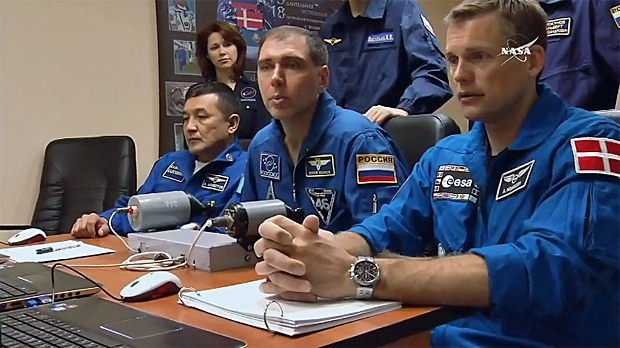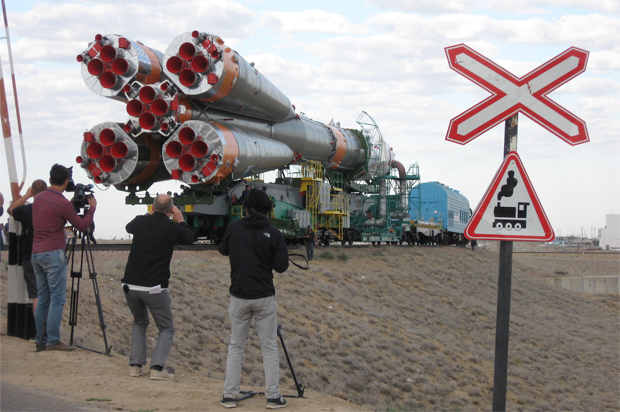Soyuz, 3-man crew, set for launch to space station
A Russian Soyuz spacecraft was prepared for launch from Kazakhstan Wednesday with a crew of three on board to deliver a fresh ferry craft to the International Space Station, a necessity for two station crew members almost halfway through a nearly yearlong stay aboard the outpost.
The crew delivering the Soyuz TMA-18M spacecraft is made up of veteran cosmonaut Sergey Volkov, European Space Agency flight engineer Andreas Mogensen of Denmark and Kazakh cosmonaut Aidyn Aimbetov, who was added to the mission after singer and would-be space tourist Sarah Brightman dropped out of training earlier this year.
Volkov is a second-generation cosmonaut making his fourth space flight. Mogensen, who will become the first Dane to fly in space, is a rookie as is Aimbetov, the second Kazakh to fly aboard a Soyuz.
If all goes well, Volkov and his crewmates will blast off from Yuri Gagarin's launch pad at the Baikonur Cosmodrome in Kazakhstan at 12:37:43 a.m. EDT Wednesday (GMT -4; 10:37 a.m. local time), roughly the moment Earth's rotation carries the launch complex into the plane of the space station's orbit.
Because of a recent debris avoidance maneuver that slightly altered the lab's orbit, the Soyuz TMA-18M spacecraft will require a two-day rendezvous profile instead of the normally favored six-hour approach first employed in 2013. As a result, docking at the Russian Poisk module is expected around 3:42 a.m. Friday.
Standing by to welcome them aboard will be station commander Gennady Padalka and his two Soyuz TMA-16M crewmates Scott Kelly and Mikhail Kornienko, launched to the station last March 27; and Soyuz TMA-17 crew members Oleg Kononenko, Japanese astronaut Kimiya Yui and NASA astronaut Kjell Lindgren, who arrived at the lab July 22.
Together, the six astronauts and cosmonauts make up the Expedition 44 crew.
With the addition of the TMA-18M crew, the station will be hosting nine crew members for the first time since November 2013 when the Olympic torch for the Winter Games in Sochi, Russia, was delivered to the lab complex.
In this case, Volkov and his crewmates are delivering a fresh Soyuz to the station to carry Kelly and Kornienko back to Earth next March after nearly a year in space. Soyuz spacecraft are certified for about 200 days in orbit and the TMA-16M ferry craft is nearing the end of its orbital lifetime.
Padalka will turn over command of the station to Kelly on Saturday, marking the end of Expedition 44 and the beginning of Expedition 45. Padalka then will return to Earth Sept. 11 aboard the TMA-16M spacecraft with Mogensen and Aimbetov. Volkov will remain aboard the station as a long-duration crew member, joining Kelly and Kornienko aboard the TMA-18M spacecraft for the return to Earth next March.
In the near term, having an additional three people aboard the station will be a welcome change for the long-duration crew members.
"We are really looking forward to this next crew that's coming up, they'll be spending about 10 days up here," Lindgren said in an interview with CBS News. "Of course, Gennady will take (his) Soyuz home and Sergey will stay up here with us. But having that group of people up here (is) going to be a lot of fun. It's going to be great to see Andy Mogensen come through the door and see him experiencing what Kimiya and I experienced for the first time just a month ago."
Padalka became the world's most experienced spaceman in June when his total time aloft over five missions eclipsed the 803-day record set by Sergei Krikalev after six space flights. When he lands Sept. 11, Padalka's record will stand at 879 days.
Kelly will have logged more than 521 days in space over four missions when he lands in March while Kornienko's mark over two station flights will stand at more than 517 days. The two men are participating in a wide variety of experiments to learn more about the long-term effects of the space environment. They will hit the halfway point in their pioneering mission on Sept. 15.
"I think it's gone extremely well from an overall science standpoint," said Bill Gerstenmaier, NASA's chief of space operations. "The joint science between the Russians and the U.S. has just been outstanding during this one-year expedition. We're at the halfway point.
"This next period, this next 180 days or so, will be very interesting to see if there are any changes, if anything occurs that's different from what we anticipated. But the rigor of the science, the data takes, has been very solid so far, and we'll continue to get that during this next period."
The Soyuz TMA-18M delivery comes on the heels of two successful space station resupply missions, one with a Russian Progress cargo ship and the other with a Japanese HTV freighter, that delivered a combined total of some 16,000 pounds of crew supplies, research gear, spare parts, water, propellant and other material.
The resupply missions followed a Progress failure in April and a SpaceX launch mishap in June that together destroyed more than 10,000 pounds of cargo. Another 5,000 pounds were lost last October when an Orbital Sciences Antares rocket exploded seconds after liftoff, destroying a Cygnus cargo ship.
Three failures in seven resupply flights deeply cut into the reserves NASA and its partners like to maintain to protect against launch mishaps and other problems.
"When we started down this road, we felt there were going to be some hiccups," Mike Suffredini, NASA's space station program manager, told CBS News in an interview. "We expected to lose a vehicle here and there, not three in eight months! ... The timing really isn't great, but I think this is part of what we could have expected to happen over time as you fly some then you lose one and then you sort through the impacts."
But with the arrival of the Progress M-28M cargo ship July 5 and the Japanese HTV cargo ship Aug. 24, the station's reserves are finally getting back to the levels NASA and its partners like to maintain.
"That gets us to about February," Suffredini said. "I think the Russians need another Progress to get them all the way to February, but by and large we're about to February."
Russia plans to launch two more Progress missions in October and November and Orbital Sciences is scheduled to launch a Cygnus cargo ship atop a United Launch Alliance Atlas 5 rocket in early December. That flight will boost U.S. reserves back to around six months.
"Orbital launches Dec. 3, ULA is working hard to hold that date for us, and with that we'll be at about six months for all of our resources and we're still able to fly research," Suffredini said. "And I think we'll have all of the spares we require."
SpaceX is still working to recover from its launch mishap and, in keeping with company practice, has provided few details about how that process is unfolding. But Suffredini said he hopes the company can resume station resupply flights in December, after at least one commercial satellite launching mission using upgraded "full-thrust" Merlin 1D engines.
"I've asked them to be ready to fly up in the December timeframe, which I think is doable for them," Suffredini said. "We've asked them to put one flight before us on the full-thrust (engines). I think they'd like to fly a couple before us, but that depends on when they get flying again. But their commitment is to try to fly us in the December timeframe."
SpaceX President Gwynne Shotwell told an aerospace conference Monday that engineers are leaving no stone unturned to make sure the next launch is a success. And that goes beyond simply replacing suspect internal struts like the one blamed for the June failure.
"We're taking more time than we originally envisioned to get back to flight, but I don't think any one of our customers wants us to race to the cliff and fail again," she said. "So we're a couple of months away from the next flight, and we will have been through a pretty thorough top-down, single-point failure review.
"Every engineer in the company is having a buddy check their work, and we're doing deep dives throughout our supply chain to make sure we don't see what we saw on our last flight."


